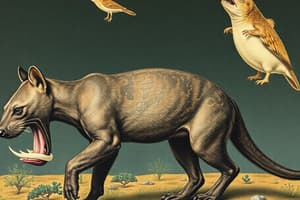Podcast
Questions and Answers
What is a characteristic of bears in terms of their diet?
What is a characteristic of bears in terms of their diet?
- They consume only plant material
- They exclusively feed on meat throughout their life cycle
- They primarily eat berries and other vegetation in the summer (correct)
- They avoid food sources when resources are scarce
What role do herbivores play in their ecosystems?
What role do herbivores play in their ecosystems?
- Primary consumers in their ecosystems (correct)
- Top predators controlling food chains
- Creating new ecosystems through plant consumption
- Decomposers breaking down organic matter
How do omnivores like pigs, humans, and birds benefit from their diet?
How do omnivores like pigs, humans, and birds benefit from their diet?
- They have specialized feeding habits
- Their diet leads to scarcity of resources
- They can utilize a wide variety of food sources (correct)
- They consume only meat for energy
How do herbivores contribute to their environments?
How do herbivores contribute to their environments?
What effect do carnivores have on the evolution of their prey?
What effect do carnivores have on the evolution of their prey?
Why is it important to understand the feeding habits of animals?
Why is it important to understand the feeding habits of animals?
What type of animals primarily consume animal tissue?
What type of animals primarily consume animal tissue?
Which category of animals consumes both animal and plant matter?
Which category of animals consumes both animal and plant matter?
What type of animals feed almost entirely on termites?
What type of animals feed almost entirely on termites?
Which animals are known for having a diet rich in proteins and fats derived from other animals?
Which animals are known for having a diet rich in proteins and fats derived from other animals?
Which type of animals are neither strictly carnivores nor herbivores?
Which type of animals are neither strictly carnivores nor herbivores?
Which category of animals requires specific nutrients found exclusively in animal tissue?
Which category of animals requires specific nutrients found exclusively in animal tissue?
Flashcards are hidden until you start studying
Study Notes
Feeding Habits of Animals: Carnivores, Omnivores, and Herbivores
As we venture into the vast web of life, delving into the diverse array of feeding habits among animals is an illuminating journey that offers insights into our planet's ecological web. Three primary categories of feeding behavior—carnivores, omnivores, and herbivores—form the foundation of this exploration.
Carnivores
Carnivores are animals that primarily consume animal tissue, making them the top-tier consumers in their ecosystems. These creatures rely on a diet rich in proteins and fats, typically derived from the flesh of other animals. For example, lions are known for their predatory prowess, striking fear into the hearts of zebras and wildebeests. Similarly, seals are marine carnivores that dive into the icy waters to catch fish and squid.
In addition to the familiar examples of carnivores like bears and sharks, there are also obligate carnivores, animals that have such a narrow diet that they require specific nutrients found exclusively in animal tissue. Examples of obligate carnivores include the Tasmanian devil, which subsists on a diet almost exclusively of carrion, and the aardwolf, which feeds almost entirely on termites.
Omnivores
Omnivores are neither strictly carnivores nor herbivores; they consume both animal and plant matter. These animals benefit from the diverse nutritional offerings of their environments, which allows them to survive in a range of habitats. For example, bears, which are classified as carnivores in some parts of their life cycle, switch to an omnivorous diet by foraging for berries and other vegetation during their summer months.
Pigs, humans, and many species of birds, such as chickens and turkeys, are all omnivores. Omnivores like these are able to make use of a wide variety of food sources, which is an advantage when resources are scarce or seasonal.
Herbivores
Herbivores are animals that consume only plant material, making them the primary consumers in their ecosystems. These animals play a vital role in maintaining the balance of their environments by consuming plant life, which in turn allows new growth to occur. For example, elephants graze on grasses and leaves in grasslands and savannas, while pandas subsist on bamboo in dense forests.
Herbivores vary in their feeding habits, from the specialized niche of the koala, which feeds almost exclusively on eucalyptus leaves, to the more generalist diet of the meadow vole, which consumes a variety of grasses and plants.
Interactions Between Feeding Habits
The feeding habits of animals influence their interactions with one another and their environments. For example, the presence of carnivores often leads to the evolution of defense mechanisms and strategies in their prey. Herbivores, in turn, can influence the distribution and abundance of vegetation in their environments.
The interconnectedness of these feeding behaviors also reflects the complexity of our planet's ecosystems. Understanding these interactions is essential for the conservation of species and the preservation of the delicate balance that sustains life on Earth.
As we learn more about the feeding habits of animals, we glean insights into their behaviors, their interactions with one another, and their roles in the broader ecosystem. These insights can help us better understand and protect the diverse array of species that call our planet home.
Studying That Suits You
Use AI to generate personalized quizzes and flashcards to suit your learning preferences.




